Cosmetic Surgery Trends and Market Analysis
VerifiedAdded on 2020/07/23
|15
|5475
|185
AI Summary
This assignment provides an overview of the cosmetic surgery market, including the decline in surgical procedures such as face/neck lifts, brow-lifts, and fat transfers in 2016. The report also highlights the growth of non-surgical treatments like botulinum toxin, dermal fillers, and lasers. Additionally, it discusses the increasing demand for facial cosmetic treatments, with a focus on the Asian market, particularly China and India. The report concludes by noting the shift from invasive to minimally invasive and non-invasive procedures, which has led to an increase in employment opportunities in this field.
Contribute Materials
Your contribution can guide someone’s learning journey. Share your
documents today.

Secure Best Marks with AI Grader
Need help grading? Try our AI Grader for instant feedback on your assignments.
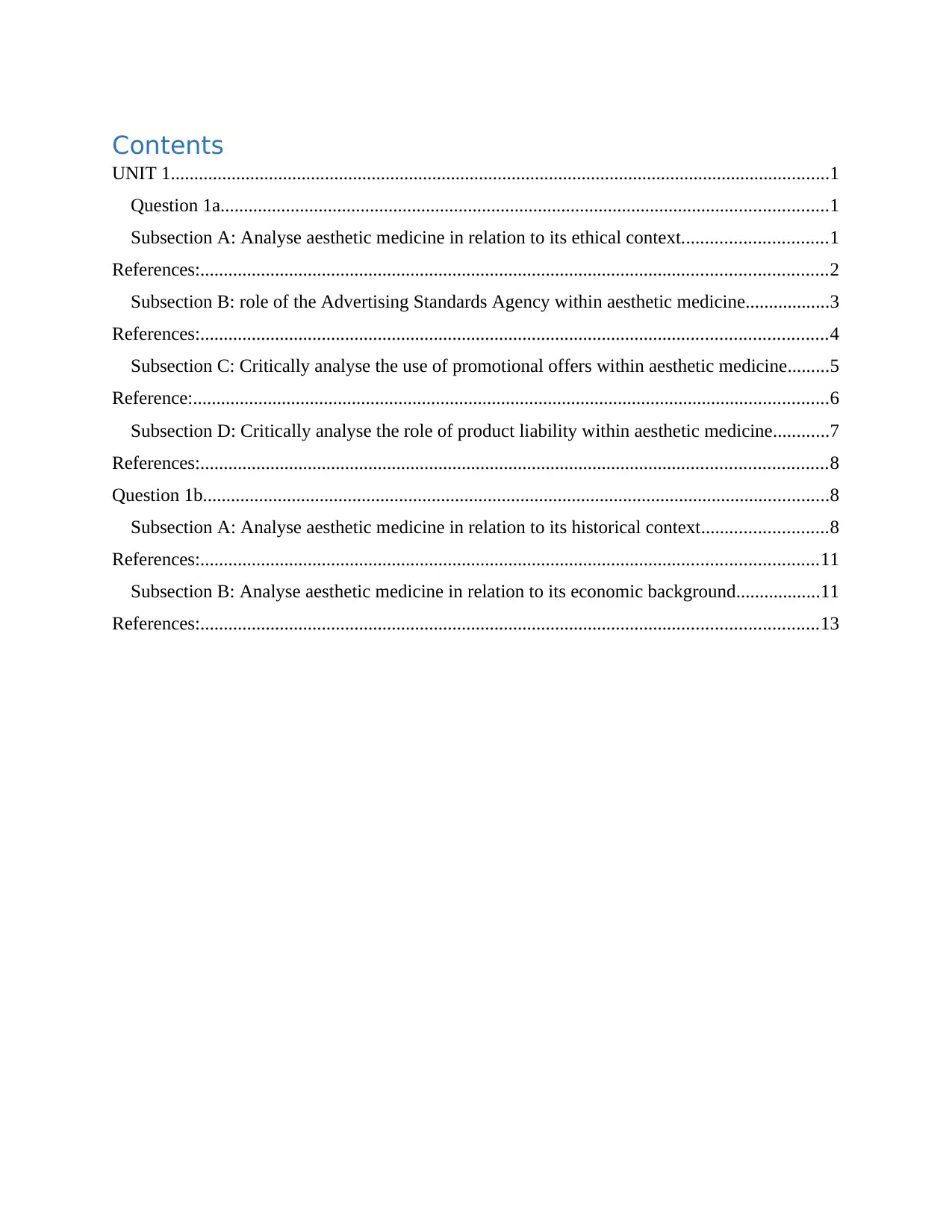
Contents
UNIT 1.............................................................................................................................................1
Question 1a..................................................................................................................................1
Subsection A: Analyse aesthetic medicine in relation to its ethical context...............................1
References:......................................................................................................................................2
Subsection B: role of the Advertising Standards Agency within aesthetic medicine..................3
References:......................................................................................................................................4
Subsection C: Critically analyse the use of promotional offers within aesthetic medicine.........5
Reference:........................................................................................................................................6
Subsection D: Critically analyse the role of product liability within aesthetic medicine............7
References:......................................................................................................................................8
Question 1b......................................................................................................................................8
Subsection A: Analyse aesthetic medicine in relation to its historical context...........................8
References:....................................................................................................................................11
Subsection B: Analyse aesthetic medicine in relation to its economic background..................11
References:....................................................................................................................................13
UNIT 1.............................................................................................................................................1
Question 1a..................................................................................................................................1
Subsection A: Analyse aesthetic medicine in relation to its ethical context...............................1
References:......................................................................................................................................2
Subsection B: role of the Advertising Standards Agency within aesthetic medicine..................3
References:......................................................................................................................................4
Subsection C: Critically analyse the use of promotional offers within aesthetic medicine.........5
Reference:........................................................................................................................................6
Subsection D: Critically analyse the role of product liability within aesthetic medicine............7
References:......................................................................................................................................8
Question 1b......................................................................................................................................8
Subsection A: Analyse aesthetic medicine in relation to its historical context...........................8
References:....................................................................................................................................11
Subsection B: Analyse aesthetic medicine in relation to its economic background..................11
References:....................................................................................................................................13
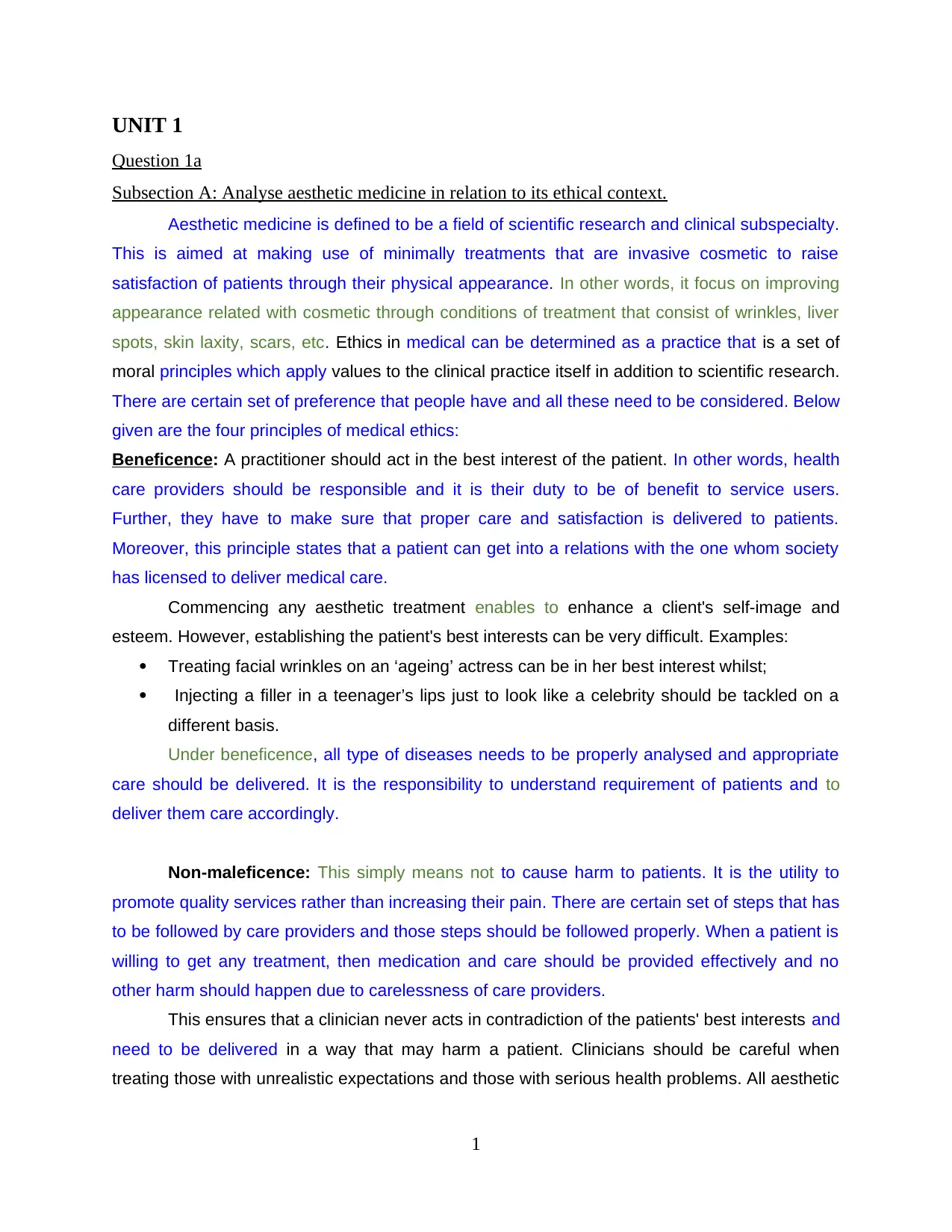
UNIT 1
Question 1a
Subsection A: Analyse aesthetic medicine in relation to its ethical context.
Aesthetic medicine is defined to be a field of scientific research and clinical subspecialty.
This is aimed at making use of minimally treatments that are invasive cosmetic to raise
satisfaction of patients through their physical appearance. In other words, it focus on improving
appearance related with cosmetic through conditions of treatment that consist of wrinkles, liver
spots, skin laxity, scars, etc. Ethics in medical can be determined as a practice that is a set of
moral principles which apply values to the clinical practice itself in addition to scientific research.
There are certain set of preference that people have and all these need to be considered. Below
given are the four principles of medical ethics:
Beneficence: A practitioner should act in the best interest of the patient. In other words, health
care providers should be responsible and it is their duty to be of benefit to service users.
Further, they have to make sure that proper care and satisfaction is delivered to patients.
Moreover, this principle states that a patient can get into a relations with the one whom society
has licensed to deliver medical care.
Commencing any aesthetic treatment enables to enhance a client's self-image and
esteem. However, establishing the patient's best interests can be very difficult. Examples:
Treating facial wrinkles on an ‘ageing’ actress can be in her best interest whilst;
Injecting a filler in a teenager’s lips just to look like a celebrity should be tackled on a
different basis.
Under beneficence, all type of diseases needs to be properly analysed and appropriate
care should be delivered. It is the responsibility to understand requirement of patients and to
deliver them care accordingly.
Non-maleficence: This simply means not to cause harm to patients. It is the utility to
promote quality services rather than increasing their pain. There are certain set of steps that has
to be followed by care providers and those steps should be followed properly. When a patient is
willing to get any treatment, then medication and care should be provided effectively and no
other harm should happen due to carelessness of care providers.
This ensures that a clinician never acts in contradiction of the patients' best interests and
need to be delivered in a way that may harm a patient. Clinicians should be careful when
treating those with unrealistic expectations and those with serious health problems. All aesthetic
1
Question 1a
Subsection A: Analyse aesthetic medicine in relation to its ethical context.
Aesthetic medicine is defined to be a field of scientific research and clinical subspecialty.
This is aimed at making use of minimally treatments that are invasive cosmetic to raise
satisfaction of patients through their physical appearance. In other words, it focus on improving
appearance related with cosmetic through conditions of treatment that consist of wrinkles, liver
spots, skin laxity, scars, etc. Ethics in medical can be determined as a practice that is a set of
moral principles which apply values to the clinical practice itself in addition to scientific research.
There are certain set of preference that people have and all these need to be considered. Below
given are the four principles of medical ethics:
Beneficence: A practitioner should act in the best interest of the patient. In other words, health
care providers should be responsible and it is their duty to be of benefit to service users.
Further, they have to make sure that proper care and satisfaction is delivered to patients.
Moreover, this principle states that a patient can get into a relations with the one whom society
has licensed to deliver medical care.
Commencing any aesthetic treatment enables to enhance a client's self-image and
esteem. However, establishing the patient's best interests can be very difficult. Examples:
Treating facial wrinkles on an ‘ageing’ actress can be in her best interest whilst;
Injecting a filler in a teenager’s lips just to look like a celebrity should be tackled on a
different basis.
Under beneficence, all type of diseases needs to be properly analysed and appropriate
care should be delivered. It is the responsibility to understand requirement of patients and to
deliver them care accordingly.
Non-maleficence: This simply means not to cause harm to patients. It is the utility to
promote quality services rather than increasing their pain. There are certain set of steps that has
to be followed by care providers and those steps should be followed properly. When a patient is
willing to get any treatment, then medication and care should be provided effectively and no
other harm should happen due to carelessness of care providers.
This ensures that a clinician never acts in contradiction of the patients' best interests and
need to be delivered in a way that may harm a patient. Clinicians should be careful when
treating those with unrealistic expectations and those with serious health problems. All aesthetic
1
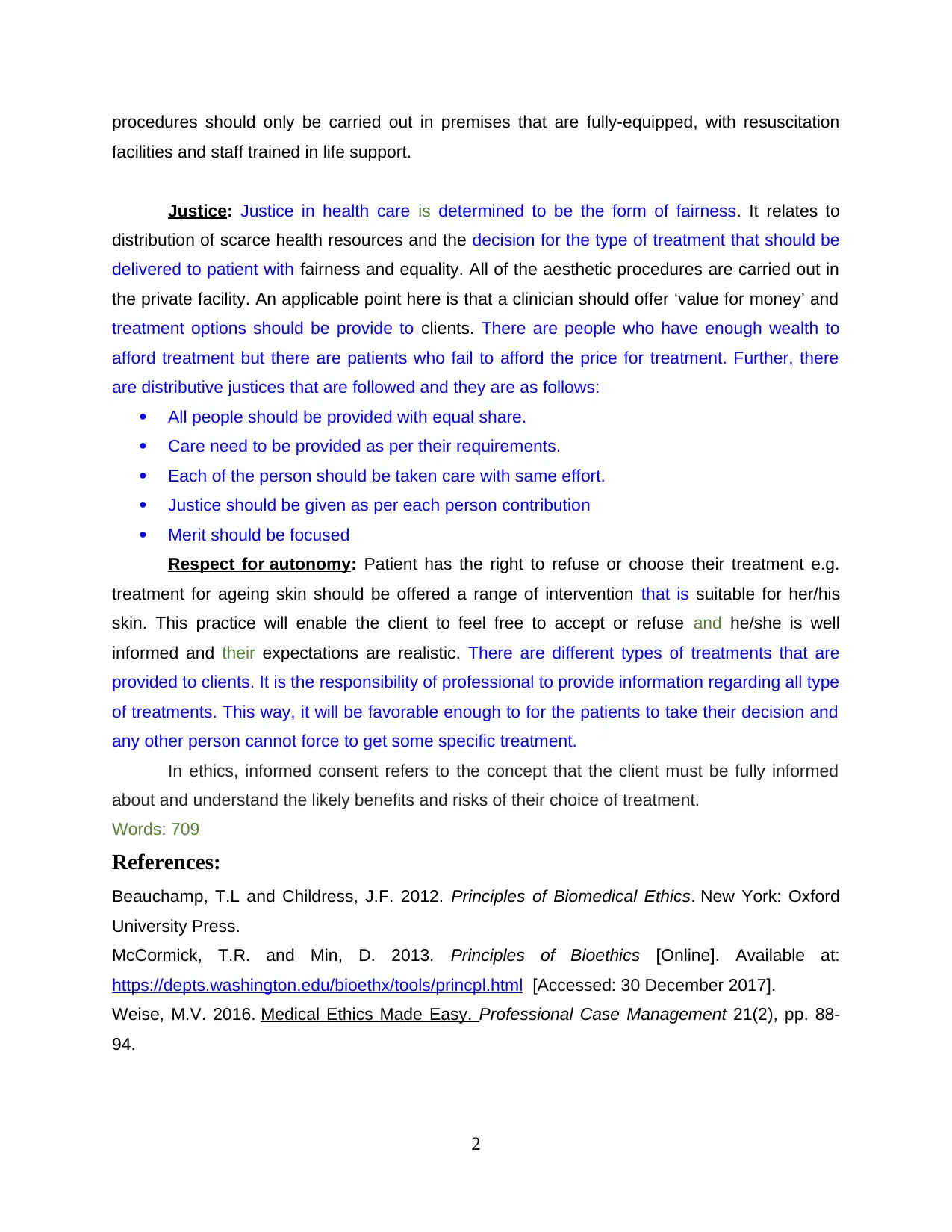
procedures should only be carried out in premises that are fully-equipped, with resuscitation
facilities and staff trained in life support.
Justice: Justice in health care is determined to be the form of fairness. It relates to
distribution of scarce health resources and the decision for the type of treatment that should be
delivered to patient with fairness and equality. All of the aesthetic procedures are carried out in
the private facility. An applicable point here is that a clinician should offer ‘value for money’ and
treatment options should be provide to clients. There are people who have enough wealth to
afford treatment but there are patients who fail to afford the price for treatment. Further, there
are distributive justices that are followed and they are as follows:
All people should be provided with equal share.
Care need to be provided as per their requirements.
Each of the person should be taken care with same effort.
Justice should be given as per each person contribution
Merit should be focused
Respect for autonomy: Patient has the right to refuse or choose their treatment e.g.
treatment for ageing skin should be offered a range of intervention that is suitable for her/his
skin. This practice will enable the client to feel free to accept or refuse and he/she is well
informed and their expectations are realistic. There are different types of treatments that are
provided to clients. It is the responsibility of professional to provide information regarding all type
of treatments. This way, it will be favorable enough to for the patients to take their decision and
any other person cannot force to get some specific treatment.
In ethics, informed consent refers to the concept that the client must be fully informed
about and understand the likely benefits and risks of their choice of treatment.
Words: 709
References:
Beauchamp, T.L and Childress, J.F. 2012. Principles of Biomedical Ethics. New York: Oxford
University Press.
McCormick, T.R. and Min, D. 2013. Principles of Bioethics [Online]. Available at:
https://depts.washington.edu/bioethx/tools/princpl.html [Accessed: 30 December 2017].
Weise, M.V. 2016. Medical Ethics Made Easy. Professional Case Management 21(2), pp. 88-
94.
2
facilities and staff trained in life support.
Justice: Justice in health care is determined to be the form of fairness. It relates to
distribution of scarce health resources and the decision for the type of treatment that should be
delivered to patient with fairness and equality. All of the aesthetic procedures are carried out in
the private facility. An applicable point here is that a clinician should offer ‘value for money’ and
treatment options should be provide to clients. There are people who have enough wealth to
afford treatment but there are patients who fail to afford the price for treatment. Further, there
are distributive justices that are followed and they are as follows:
All people should be provided with equal share.
Care need to be provided as per their requirements.
Each of the person should be taken care with same effort.
Justice should be given as per each person contribution
Merit should be focused
Respect for autonomy: Patient has the right to refuse or choose their treatment e.g.
treatment for ageing skin should be offered a range of intervention that is suitable for her/his
skin. This practice will enable the client to feel free to accept or refuse and he/she is well
informed and their expectations are realistic. There are different types of treatments that are
provided to clients. It is the responsibility of professional to provide information regarding all type
of treatments. This way, it will be favorable enough to for the patients to take their decision and
any other person cannot force to get some specific treatment.
In ethics, informed consent refers to the concept that the client must be fully informed
about and understand the likely benefits and risks of their choice of treatment.
Words: 709
References:
Beauchamp, T.L and Childress, J.F. 2012. Principles of Biomedical Ethics. New York: Oxford
University Press.
McCormick, T.R. and Min, D. 2013. Principles of Bioethics [Online]. Available at:
https://depts.washington.edu/bioethx/tools/princpl.html [Accessed: 30 December 2017].
Weise, M.V. 2016. Medical Ethics Made Easy. Professional Case Management 21(2), pp. 88-
94.
2
Secure Best Marks with AI Grader
Need help grading? Try our AI Grader for instant feedback on your assignments.
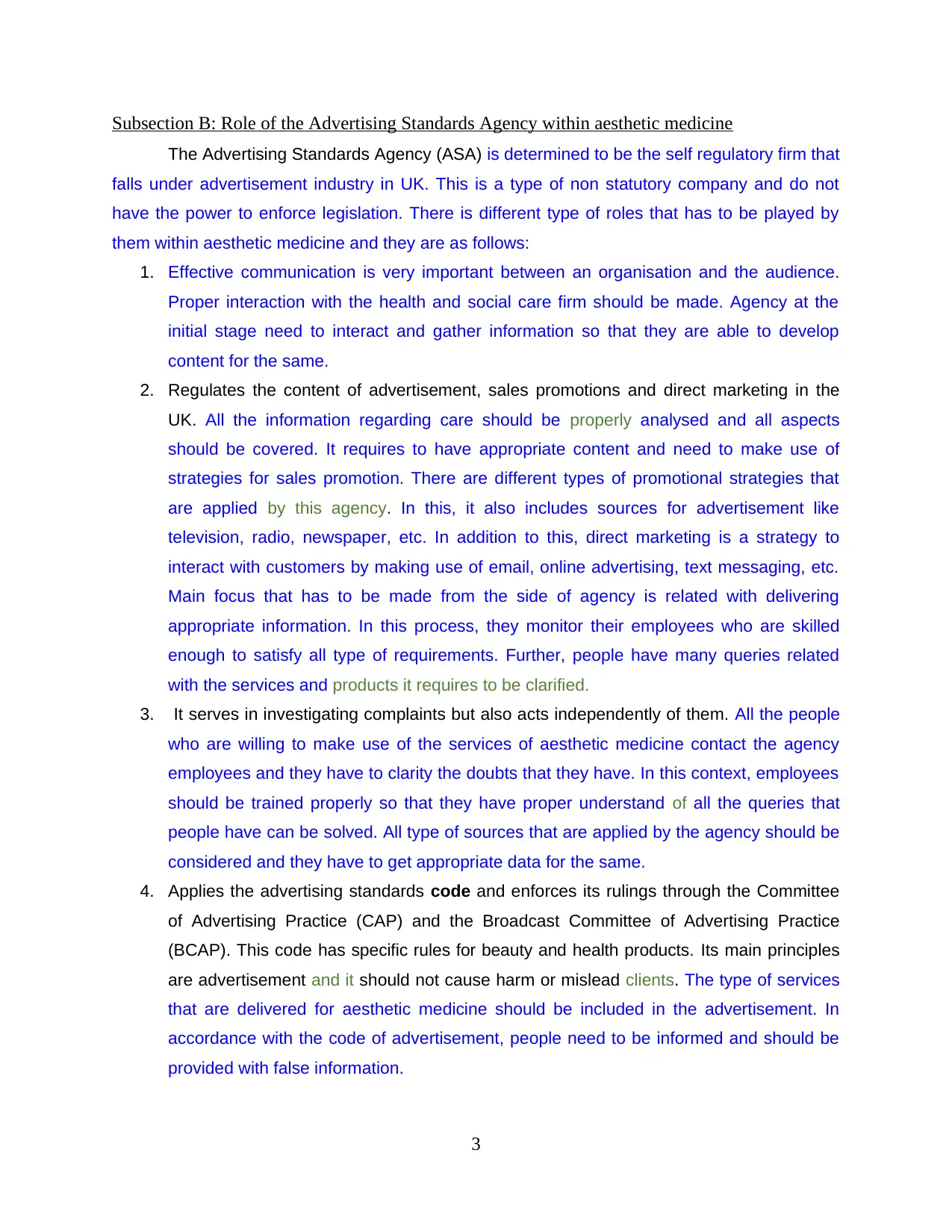
Subsection B: Role of the Advertising Standards Agency within aesthetic medicine
The Advertising Standards Agency (ASA) is determined to be the self regulatory firm that
falls under advertisement industry in UK. This is a type of non statutory company and do not
have the power to enforce legislation. There is different type of roles that has to be played by
them within aesthetic medicine and they are as follows:
1. Effective communication is very important between an organisation and the audience.
Proper interaction with the health and social care firm should be made. Agency at the
initial stage need to interact and gather information so that they are able to develop
content for the same.
2. Regulates the content of advertisement, sales promotions and direct marketing in the
UK. All the information regarding care should be properly analysed and all aspects
should be covered. It requires to have appropriate content and need to make use of
strategies for sales promotion. There are different types of promotional strategies that
are applied by this agency. In this, it also includes sources for advertisement like
television, radio, newspaper, etc. In addition to this, direct marketing is a strategy to
interact with customers by making use of email, online advertising, text messaging, etc.
Main focus that has to be made from the side of agency is related with delivering
appropriate information. In this process, they monitor their employees who are skilled
enough to satisfy all type of requirements. Further, people have many queries related
with the services and products it requires to be clarified.
3. It serves in investigating complaints but also acts independently of them. All the people
who are willing to make use of the services of aesthetic medicine contact the agency
employees and they have to clarity the doubts that they have. In this context, employees
should be trained properly so that they have proper understand of all the queries that
people have can be solved. All type of sources that are applied by the agency should be
considered and they have to get appropriate data for the same.
4. Applies the advertising standards code and enforces its rulings through the Committee
of Advertising Practice (CAP) and the Broadcast Committee of Advertising Practice
(BCAP). This code has specific rules for beauty and health products. Its main principles
are advertisement and it should not cause harm or mislead clients. The type of services
that are delivered for aesthetic medicine should be included in the advertisement. In
accordance with the code of advertisement, people need to be informed and should be
provided with false information.
3
The Advertising Standards Agency (ASA) is determined to be the self regulatory firm that
falls under advertisement industry in UK. This is a type of non statutory company and do not
have the power to enforce legislation. There is different type of roles that has to be played by
them within aesthetic medicine and they are as follows:
1. Effective communication is very important between an organisation and the audience.
Proper interaction with the health and social care firm should be made. Agency at the
initial stage need to interact and gather information so that they are able to develop
content for the same.
2. Regulates the content of advertisement, sales promotions and direct marketing in the
UK. All the information regarding care should be properly analysed and all aspects
should be covered. It requires to have appropriate content and need to make use of
strategies for sales promotion. There are different types of promotional strategies that
are applied by this agency. In this, it also includes sources for advertisement like
television, radio, newspaper, etc. In addition to this, direct marketing is a strategy to
interact with customers by making use of email, online advertising, text messaging, etc.
Main focus that has to be made from the side of agency is related with delivering
appropriate information. In this process, they monitor their employees who are skilled
enough to satisfy all type of requirements. Further, people have many queries related
with the services and products it requires to be clarified.
3. It serves in investigating complaints but also acts independently of them. All the people
who are willing to make use of the services of aesthetic medicine contact the agency
employees and they have to clarity the doubts that they have. In this context, employees
should be trained properly so that they have proper understand of all the queries that
people have can be solved. All type of sources that are applied by the agency should be
considered and they have to get appropriate data for the same.
4. Applies the advertising standards code and enforces its rulings through the Committee
of Advertising Practice (CAP) and the Broadcast Committee of Advertising Practice
(BCAP). This code has specific rules for beauty and health products. Its main principles
are advertisement and it should not cause harm or mislead clients. The type of services
that are delivered for aesthetic medicine should be included in the advertisement. In
accordance with the code of advertisement, people need to be informed and should be
provided with false information.
3
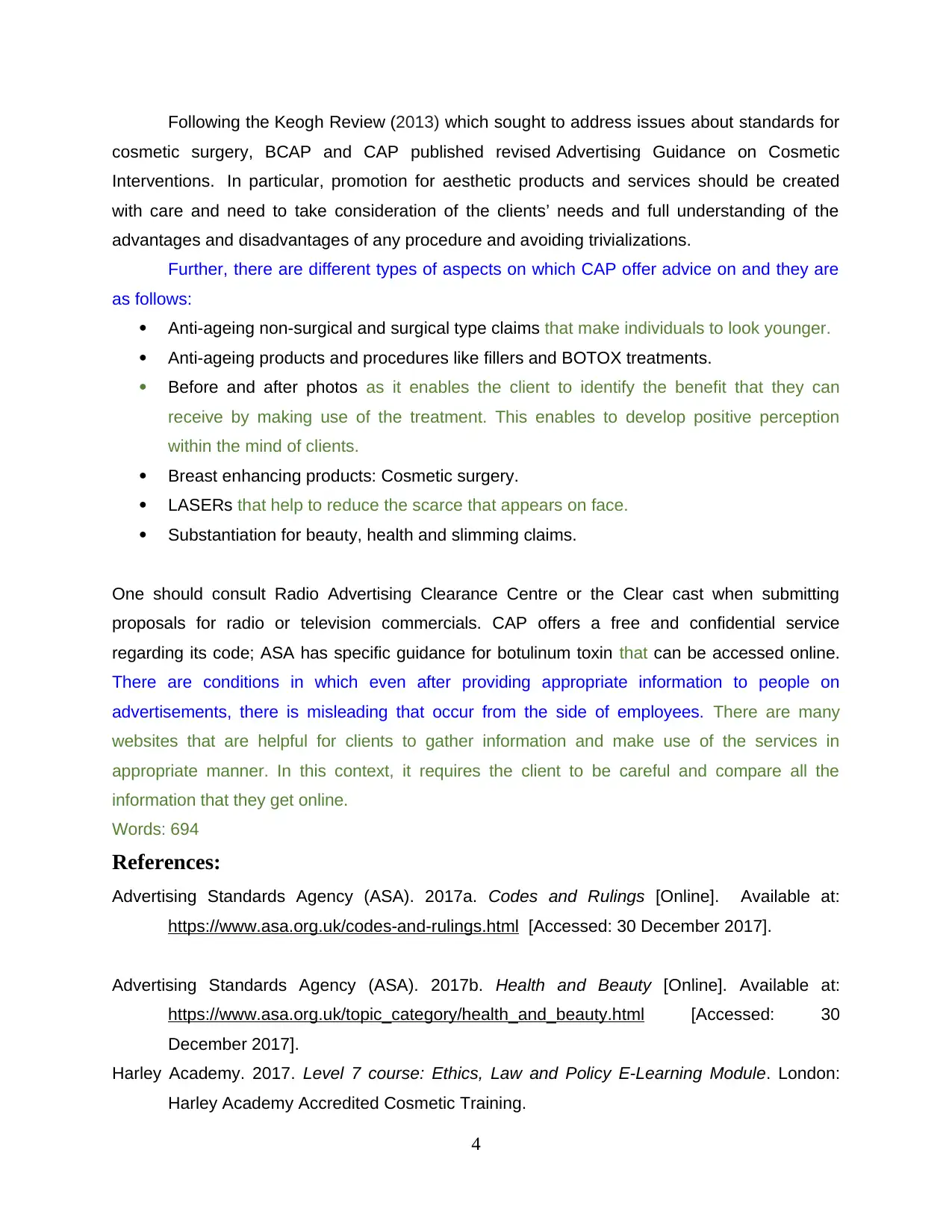
Following the Keogh Review (2013) which sought to address issues about standards for
cosmetic surgery, BCAP and CAP published revised Advertising Guidance on Cosmetic
Interventions. In particular, promotion for aesthetic products and services should be created
with care and need to take consideration of the clients’ needs and full understanding of the
advantages and disadvantages of any procedure and avoiding trivializations.
Further, there are different types of aspects on which CAP offer advice on and they are
as follows:
Anti-ageing non-surgical and surgical type claims that make individuals to look younger.
Anti-ageing products and procedures like fillers and BOTOX treatments.
Before and after photos as it enables the client to identify the benefit that they can
receive by making use of the treatment. This enables to develop positive perception
within the mind of clients.
Breast enhancing products: Cosmetic surgery.
LASERs that help to reduce the scarce that appears on face.
Substantiation for beauty, health and slimming claims.
One should consult Radio Advertising Clearance Centre or the Clear cast when submitting
proposals for radio or television commercials. CAP offers a free and confidential service
regarding its code; ASA has specific guidance for botulinum toxin that can be accessed online.
There are conditions in which even after providing appropriate information to people on
advertisements, there is misleading that occur from the side of employees. There are many
websites that are helpful for clients to gather information and make use of the services in
appropriate manner. In this context, it requires the client to be careful and compare all the
information that they get online.
Words: 694
References:
Advertising Standards Agency (ASA). 2017a. Codes and Rulings [Online]. Available at:
https://www.asa.org.uk/codes-and-rulings.html [Accessed: 30 December 2017].
Advertising Standards Agency (ASA). 2017b. Health and Beauty [Online]. Available at:
https://www.asa.org.uk/topic_category/health_and_beauty.html [Accessed: 30
December 2017].
Harley Academy. 2017. Level 7 course: Ethics, Law and Policy E-Learning Module. London:
Harley Academy Accredited Cosmetic Training.
4
cosmetic surgery, BCAP and CAP published revised Advertising Guidance on Cosmetic
Interventions. In particular, promotion for aesthetic products and services should be created
with care and need to take consideration of the clients’ needs and full understanding of the
advantages and disadvantages of any procedure and avoiding trivializations.
Further, there are different types of aspects on which CAP offer advice on and they are
as follows:
Anti-ageing non-surgical and surgical type claims that make individuals to look younger.
Anti-ageing products and procedures like fillers and BOTOX treatments.
Before and after photos as it enables the client to identify the benefit that they can
receive by making use of the treatment. This enables to develop positive perception
within the mind of clients.
Breast enhancing products: Cosmetic surgery.
LASERs that help to reduce the scarce that appears on face.
Substantiation for beauty, health and slimming claims.
One should consult Radio Advertising Clearance Centre or the Clear cast when submitting
proposals for radio or television commercials. CAP offers a free and confidential service
regarding its code; ASA has specific guidance for botulinum toxin that can be accessed online.
There are conditions in which even after providing appropriate information to people on
advertisements, there is misleading that occur from the side of employees. There are many
websites that are helpful for clients to gather information and make use of the services in
appropriate manner. In this context, it requires the client to be careful and compare all the
information that they get online.
Words: 694
References:
Advertising Standards Agency (ASA). 2017a. Codes and Rulings [Online]. Available at:
https://www.asa.org.uk/codes-and-rulings.html [Accessed: 30 December 2017].
Advertising Standards Agency (ASA). 2017b. Health and Beauty [Online]. Available at:
https://www.asa.org.uk/topic_category/health_and_beauty.html [Accessed: 30
December 2017].
Harley Academy. 2017. Level 7 course: Ethics, Law and Policy E-Learning Module. London:
Harley Academy Accredited Cosmetic Training.
4
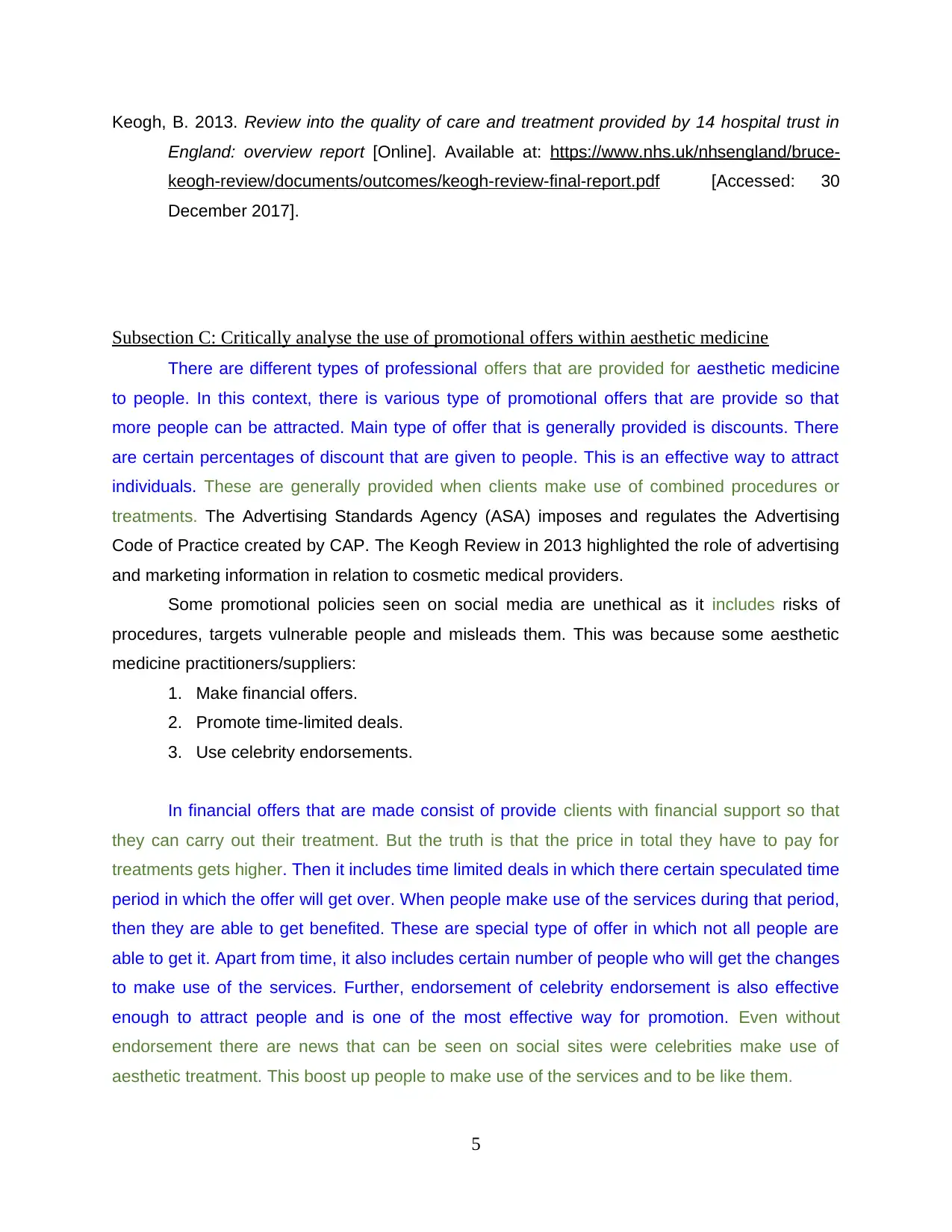
Keogh, B. 2013. Review into the quality of care and treatment provided by 14 hospital trust in
England: overview report [Online]. Available at: https://www.nhs.uk/nhsengland/bruce-
keogh-review/documents/outcomes/keogh-review-final-report.pdf [Accessed: 30
December 2017].
Subsection C: Critically analyse the use of promotional offers within aesthetic medicine
There are different types of professional offers that are provided for aesthetic medicine
to people. In this context, there is various type of promotional offers that are provide so that
more people can be attracted. Main type of offer that is generally provided is discounts. There
are certain percentages of discount that are given to people. This is an effective way to attract
individuals. These are generally provided when clients make use of combined procedures or
treatments. The Advertising Standards Agency (ASA) imposes and regulates the Advertising
Code of Practice created by CAP. The Keogh Review in 2013 highlighted the role of advertising
and marketing information in relation to cosmetic medical providers.
Some promotional policies seen on social media are unethical as it includes risks of
procedures, targets vulnerable people and misleads them. This was because some aesthetic
medicine practitioners/suppliers:
1. Make financial offers.
2. Promote time-limited deals.
3. Use celebrity endorsements.
In financial offers that are made consist of provide clients with financial support so that
they can carry out their treatment. But the truth is that the price in total they have to pay for
treatments gets higher. Then it includes time limited deals in which there certain speculated time
period in which the offer will get over. When people make use of the services during that period,
then they are able to get benefited. These are special type of offer in which not all people are
able to get it. Apart from time, it also includes certain number of people who will get the changes
to make use of the services. Further, endorsement of celebrity endorsement is also effective
enough to attract people and is one of the most effective way for promotion. Even without
endorsement there are news that can be seen on social sites were celebrities make use of
aesthetic treatment. This boost up people to make use of the services and to be like them.
5
England: overview report [Online]. Available at: https://www.nhs.uk/nhsengland/bruce-
keogh-review/documents/outcomes/keogh-review-final-report.pdf [Accessed: 30
December 2017].
Subsection C: Critically analyse the use of promotional offers within aesthetic medicine
There are different types of professional offers that are provided for aesthetic medicine
to people. In this context, there is various type of promotional offers that are provide so that
more people can be attracted. Main type of offer that is generally provided is discounts. There
are certain percentages of discount that are given to people. This is an effective way to attract
individuals. These are generally provided when clients make use of combined procedures or
treatments. The Advertising Standards Agency (ASA) imposes and regulates the Advertising
Code of Practice created by CAP. The Keogh Review in 2013 highlighted the role of advertising
and marketing information in relation to cosmetic medical providers.
Some promotional policies seen on social media are unethical as it includes risks of
procedures, targets vulnerable people and misleads them. This was because some aesthetic
medicine practitioners/suppliers:
1. Make financial offers.
2. Promote time-limited deals.
3. Use celebrity endorsements.
In financial offers that are made consist of provide clients with financial support so that
they can carry out their treatment. But the truth is that the price in total they have to pay for
treatments gets higher. Then it includes time limited deals in which there certain speculated time
period in which the offer will get over. When people make use of the services during that period,
then they are able to get benefited. These are special type of offer in which not all people are
able to get it. Apart from time, it also includes certain number of people who will get the changes
to make use of the services. Further, endorsement of celebrity endorsement is also effective
enough to attract people and is one of the most effective way for promotion. Even without
endorsement there are news that can be seen on social sites were celebrities make use of
aesthetic treatment. This boost up people to make use of the services and to be like them.
5
Paraphrase This Document
Need a fresh take? Get an instant paraphrase of this document with our AI Paraphraser
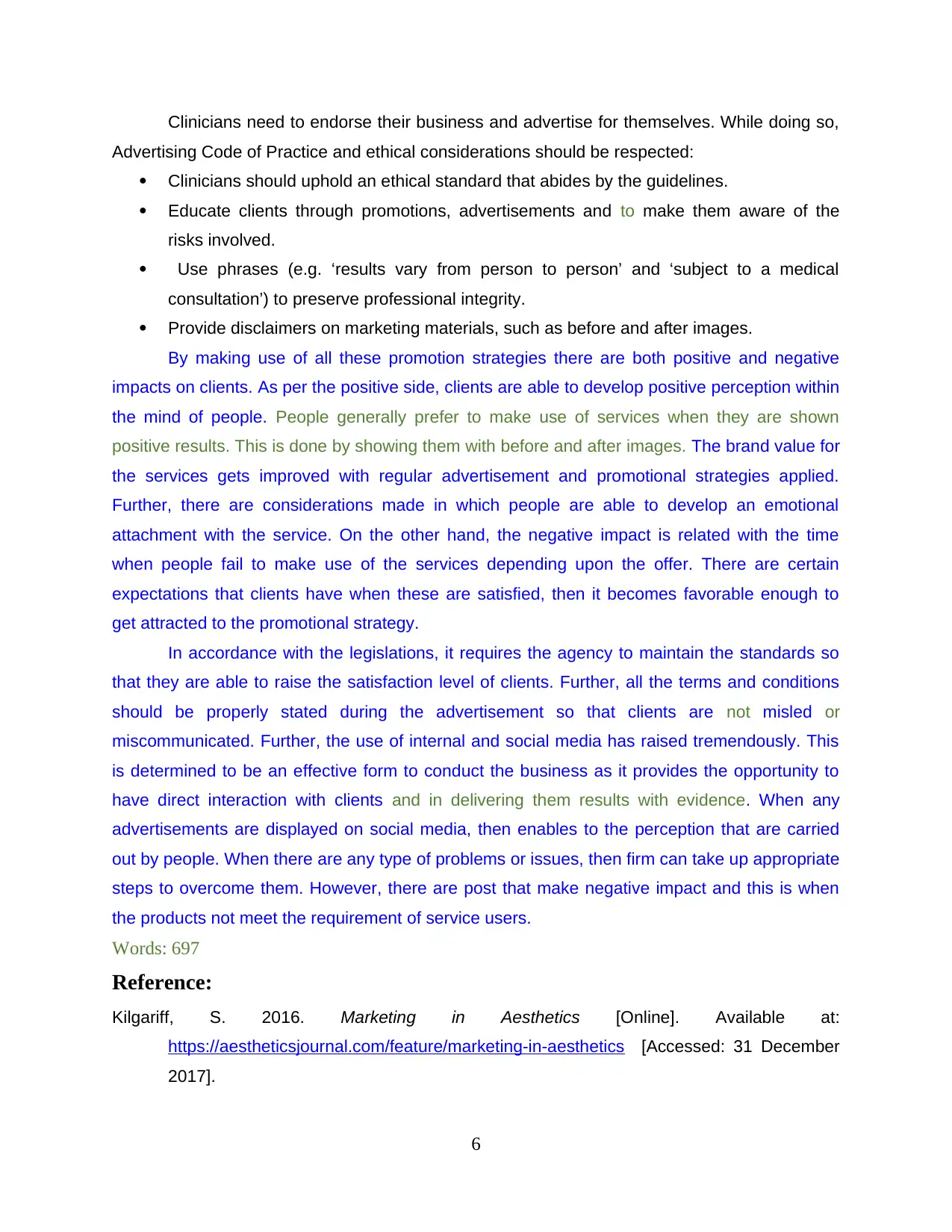
Clinicians need to endorse their business and advertise for themselves. While doing so,
Advertising Code of Practice and ethical considerations should be respected:
Clinicians should uphold an ethical standard that abides by the guidelines.
Educate clients through promotions, advertisements and to make them aware of the
risks involved.
Use phrases (e.g. ‘results vary from person to person’ and ‘subject to a medical
consultation’) to preserve professional integrity.
Provide disclaimers on marketing materials, such as before and after images.
By making use of all these promotion strategies there are both positive and negative
impacts on clients. As per the positive side, clients are able to develop positive perception within
the mind of people. People generally prefer to make use of services when they are shown
positive results. This is done by showing them with before and after images. The brand value for
the services gets improved with regular advertisement and promotional strategies applied.
Further, there are considerations made in which people are able to develop an emotional
attachment with the service. On the other hand, the negative impact is related with the time
when people fail to make use of the services depending upon the offer. There are certain
expectations that clients have when these are satisfied, then it becomes favorable enough to
get attracted to the promotional strategy.
In accordance with the legislations, it requires the agency to maintain the standards so
that they are able to raise the satisfaction level of clients. Further, all the terms and conditions
should be properly stated during the advertisement so that clients are not misled or
miscommunicated. Further, the use of internal and social media has raised tremendously. This
is determined to be an effective form to conduct the business as it provides the opportunity to
have direct interaction with clients and in delivering them results with evidence. When any
advertisements are displayed on social media, then enables to the perception that are carried
out by people. When there are any type of problems or issues, then firm can take up appropriate
steps to overcome them. However, there are post that make negative impact and this is when
the products not meet the requirement of service users.
Words: 697
Reference:
Kilgariff, S. 2016. Marketing in Aesthetics [Online]. Available at:
https://aestheticsjournal.com/feature/marketing-in-aesthetics [Accessed: 31 December
2017].
6
Advertising Code of Practice and ethical considerations should be respected:
Clinicians should uphold an ethical standard that abides by the guidelines.
Educate clients through promotions, advertisements and to make them aware of the
risks involved.
Use phrases (e.g. ‘results vary from person to person’ and ‘subject to a medical
consultation’) to preserve professional integrity.
Provide disclaimers on marketing materials, such as before and after images.
By making use of all these promotion strategies there are both positive and negative
impacts on clients. As per the positive side, clients are able to develop positive perception within
the mind of people. People generally prefer to make use of services when they are shown
positive results. This is done by showing them with before and after images. The brand value for
the services gets improved with regular advertisement and promotional strategies applied.
Further, there are considerations made in which people are able to develop an emotional
attachment with the service. On the other hand, the negative impact is related with the time
when people fail to make use of the services depending upon the offer. There are certain
expectations that clients have when these are satisfied, then it becomes favorable enough to
get attracted to the promotional strategy.
In accordance with the legislations, it requires the agency to maintain the standards so
that they are able to raise the satisfaction level of clients. Further, all the terms and conditions
should be properly stated during the advertisement so that clients are not misled or
miscommunicated. Further, the use of internal and social media has raised tremendously. This
is determined to be an effective form to conduct the business as it provides the opportunity to
have direct interaction with clients and in delivering them results with evidence. When any
advertisements are displayed on social media, then enables to the perception that are carried
out by people. When there are any type of problems or issues, then firm can take up appropriate
steps to overcome them. However, there are post that make negative impact and this is when
the products not meet the requirement of service users.
Words: 697
Reference:
Kilgariff, S. 2016. Marketing in Aesthetics [Online]. Available at:
https://aestheticsjournal.com/feature/marketing-in-aesthetics [Accessed: 31 December
2017].
6
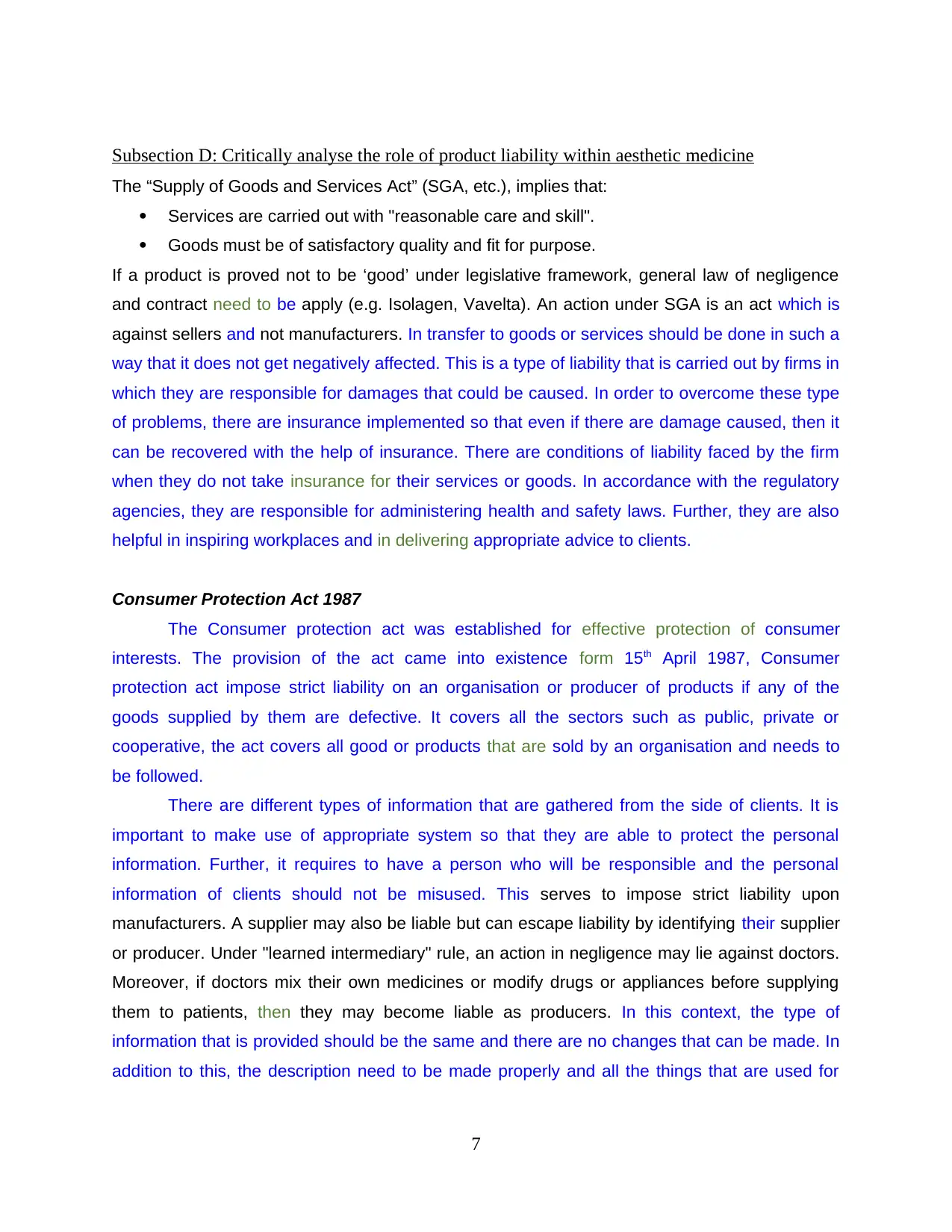
Subsection D: Critically analyse the role of product liability within aesthetic medicine
The “Supply of Goods and Services Act” (SGA, etc.), implies that:
Services are carried out with "reasonable care and skill".
Goods must be of satisfactory quality and fit for purpose.
If a product is proved not to be ‘good’ under legislative framework, general law of negligence
and contract need to be apply (e.g. Isolagen, Vavelta). An action under SGA is an act which is
against sellers and not manufacturers. In transfer to goods or services should be done in such a
way that it does not get negatively affected. This is a type of liability that is carried out by firms in
which they are responsible for damages that could be caused. In order to overcome these type
of problems, there are insurance implemented so that even if there are damage caused, then it
can be recovered with the help of insurance. There are conditions of liability faced by the firm
when they do not take insurance for their services or goods. In accordance with the regulatory
agencies, they are responsible for administering health and safety laws. Further, they are also
helpful in inspiring workplaces and in delivering appropriate advice to clients.
Consumer Protection Act 1987
The Consumer protection act was established for effective protection of consumer
interests. The provision of the act came into existence form 15th April 1987, Consumer
protection act impose strict liability on an organisation or producer of products if any of the
goods supplied by them are defective. It covers all the sectors such as public, private or
cooperative, the act covers all good or products that are sold by an organisation and needs to
be followed.
There are different types of information that are gathered from the side of clients. It is
important to make use of appropriate system so that they are able to protect the personal
information. Further, it requires to have a person who will be responsible and the personal
information of clients should not be misused. This serves to impose strict liability upon
manufacturers. A supplier may also be liable but can escape liability by identifying their supplier
or producer. Under "learned intermediary" rule, an action in negligence may lie against doctors.
Moreover, if doctors mix their own medicines or modify drugs or appliances before supplying
them to patients, then they may become liable as producers. In this context, the type of
information that is provided should be the same and there are no changes that can be made. In
addition to this, the description need to be made properly and all the things that are used for
7
The “Supply of Goods and Services Act” (SGA, etc.), implies that:
Services are carried out with "reasonable care and skill".
Goods must be of satisfactory quality and fit for purpose.
If a product is proved not to be ‘good’ under legislative framework, general law of negligence
and contract need to be apply (e.g. Isolagen, Vavelta). An action under SGA is an act which is
against sellers and not manufacturers. In transfer to goods or services should be done in such a
way that it does not get negatively affected. This is a type of liability that is carried out by firms in
which they are responsible for damages that could be caused. In order to overcome these type
of problems, there are insurance implemented so that even if there are damage caused, then it
can be recovered with the help of insurance. There are conditions of liability faced by the firm
when they do not take insurance for their services or goods. In accordance with the regulatory
agencies, they are responsible for administering health and safety laws. Further, they are also
helpful in inspiring workplaces and in delivering appropriate advice to clients.
Consumer Protection Act 1987
The Consumer protection act was established for effective protection of consumer
interests. The provision of the act came into existence form 15th April 1987, Consumer
protection act impose strict liability on an organisation or producer of products if any of the
goods supplied by them are defective. It covers all the sectors such as public, private or
cooperative, the act covers all good or products that are sold by an organisation and needs to
be followed.
There are different types of information that are gathered from the side of clients. It is
important to make use of appropriate system so that they are able to protect the personal
information. Further, it requires to have a person who will be responsible and the personal
information of clients should not be misused. This serves to impose strict liability upon
manufacturers. A supplier may also be liable but can escape liability by identifying their supplier
or producer. Under "learned intermediary" rule, an action in negligence may lie against doctors.
Moreover, if doctors mix their own medicines or modify drugs or appliances before supplying
them to patients, then they may become liable as producers. In this context, the type of
information that is provided should be the same and there are no changes that can be made. In
addition to this, the description need to be made properly and all the things that are used for
7
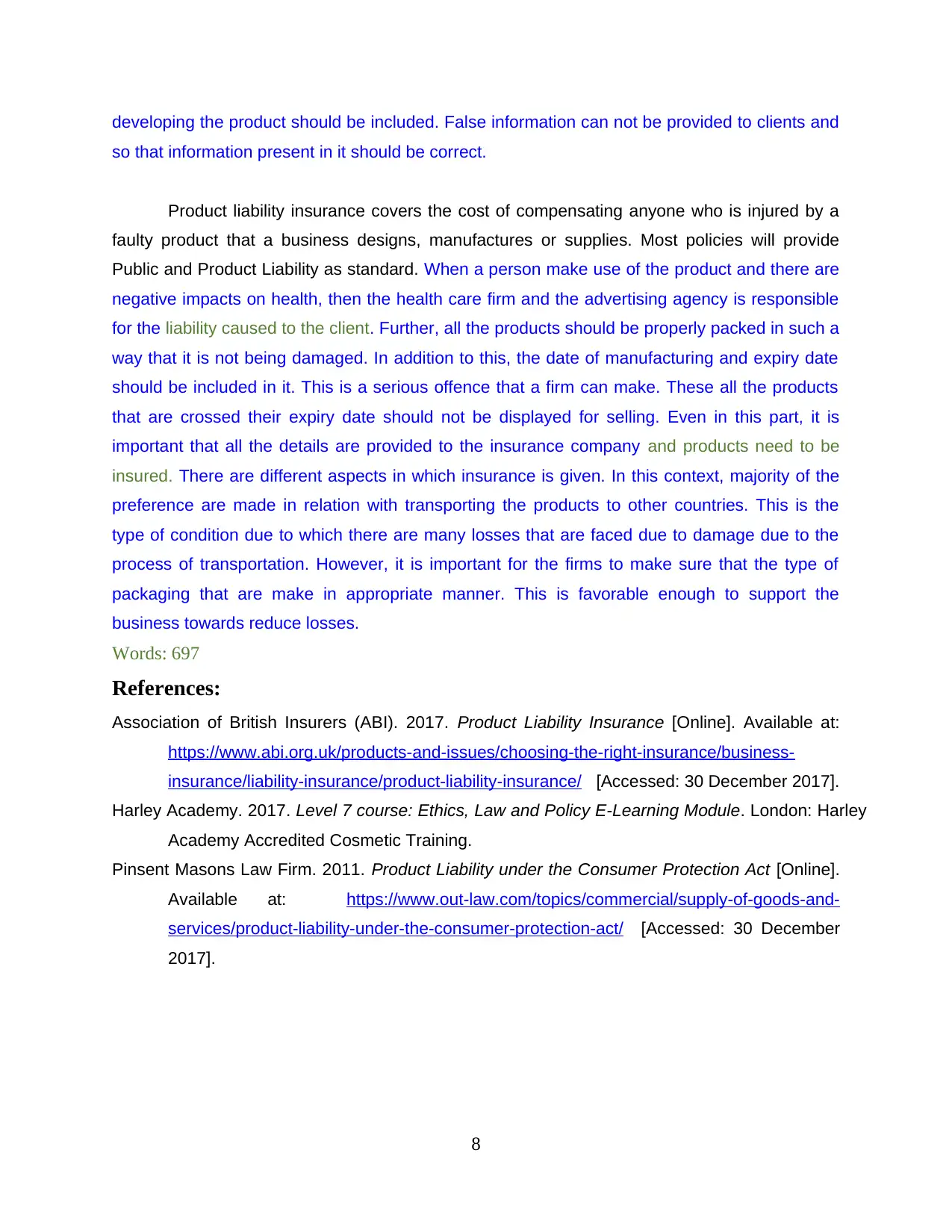
developing the product should be included. False information can not be provided to clients and
so that information present in it should be correct.
Product liability insurance covers the cost of compensating anyone who is injured by a
faulty product that a business designs, manufactures or supplies. Most policies will provide
Public and Product Liability as standard. When a person make use of the product and there are
negative impacts on health, then the health care firm and the advertising agency is responsible
for the liability caused to the client. Further, all the products should be properly packed in such a
way that it is not being damaged. In addition to this, the date of manufacturing and expiry date
should be included in it. This is a serious offence that a firm can make. These all the products
that are crossed their expiry date should not be displayed for selling. Even in this part, it is
important that all the details are provided to the insurance company and products need to be
insured. There are different aspects in which insurance is given. In this context, majority of the
preference are made in relation with transporting the products to other countries. This is the
type of condition due to which there are many losses that are faced due to damage due to the
process of transportation. However, it is important for the firms to make sure that the type of
packaging that are make in appropriate manner. This is favorable enough to support the
business towards reduce losses.
Words: 697
References:
Association of British Insurers (ABI). 2017. Product Liability Insurance [Online]. Available at:
https://www.abi.org.uk/products-and-issues/choosing-the-right-insurance/business-
insurance/liability-insurance/product-liability-insurance/ [Accessed: 30 December 2017].
Harley Academy. 2017. Level 7 course: Ethics, Law and Policy E-Learning Module. London: Harley
Academy Accredited Cosmetic Training.
Pinsent Masons Law Firm. 2011. Product Liability under the Consumer Protection Act [Online].
Available at: https://www.out-law.com/topics/commercial/supply-of-goods-and-
services/product-liability-under-the-consumer-protection-act/ [Accessed: 30 December
2017].
8
so that information present in it should be correct.
Product liability insurance covers the cost of compensating anyone who is injured by a
faulty product that a business designs, manufactures or supplies. Most policies will provide
Public and Product Liability as standard. When a person make use of the product and there are
negative impacts on health, then the health care firm and the advertising agency is responsible
for the liability caused to the client. Further, all the products should be properly packed in such a
way that it is not being damaged. In addition to this, the date of manufacturing and expiry date
should be included in it. This is a serious offence that a firm can make. These all the products
that are crossed their expiry date should not be displayed for selling. Even in this part, it is
important that all the details are provided to the insurance company and products need to be
insured. There are different aspects in which insurance is given. In this context, majority of the
preference are made in relation with transporting the products to other countries. This is the
type of condition due to which there are many losses that are faced due to damage due to the
process of transportation. However, it is important for the firms to make sure that the type of
packaging that are make in appropriate manner. This is favorable enough to support the
business towards reduce losses.
Words: 697
References:
Association of British Insurers (ABI). 2017. Product Liability Insurance [Online]. Available at:
https://www.abi.org.uk/products-and-issues/choosing-the-right-insurance/business-
insurance/liability-insurance/product-liability-insurance/ [Accessed: 30 December 2017].
Harley Academy. 2017. Level 7 course: Ethics, Law and Policy E-Learning Module. London: Harley
Academy Accredited Cosmetic Training.
Pinsent Masons Law Firm. 2011. Product Liability under the Consumer Protection Act [Online].
Available at: https://www.out-law.com/topics/commercial/supply-of-goods-and-
services/product-liability-under-the-consumer-protection-act/ [Accessed: 30 December
2017].
8
Secure Best Marks with AI Grader
Need help grading? Try our AI Grader for instant feedback on your assignments.
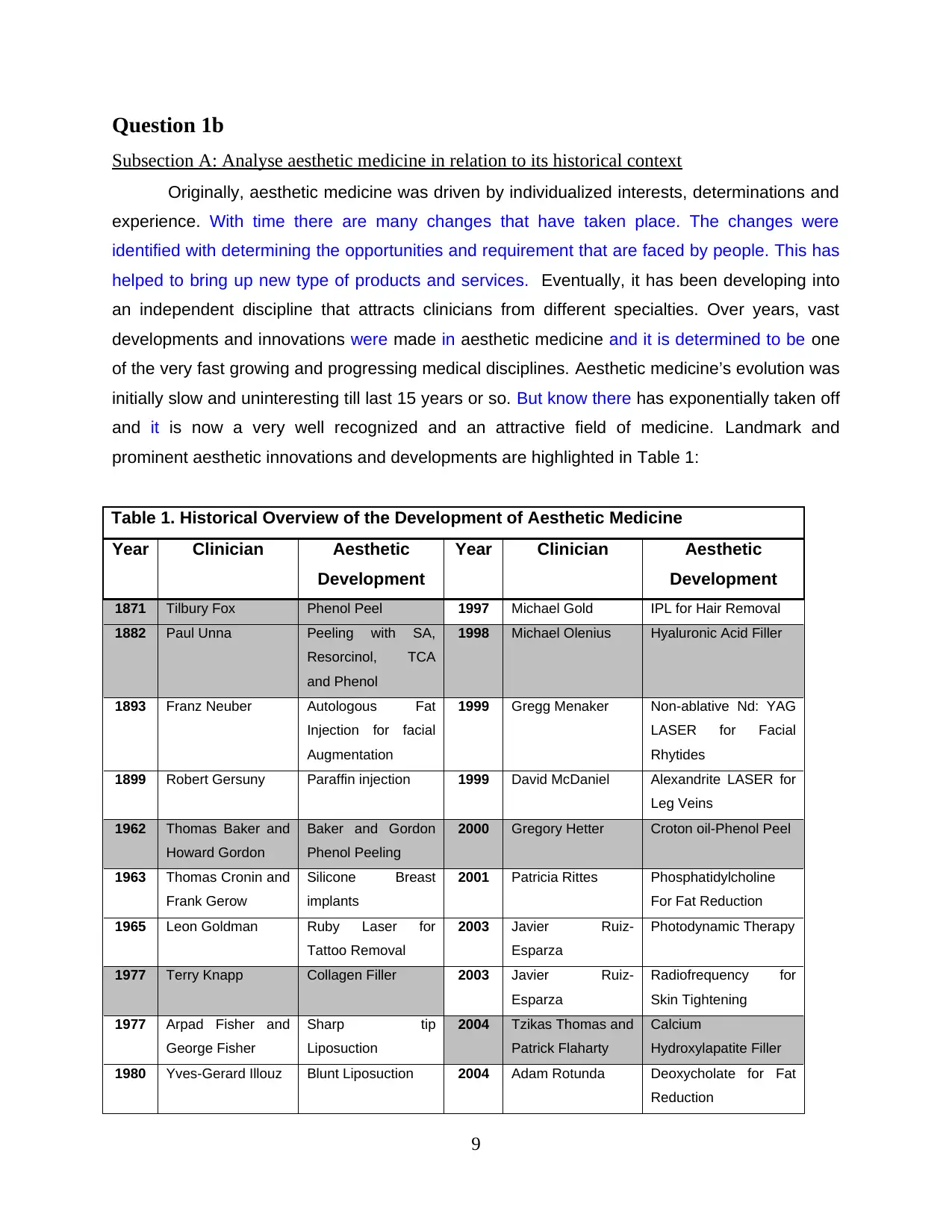
Question 1b
Subsection A: Analyse aesthetic medicine in relation to its historical context
Originally, aesthetic medicine was driven by individualized interests, determinations and
experience. With time there are many changes that have taken place. The changes were
identified with determining the opportunities and requirement that are faced by people. This has
helped to bring up new type of products and services. Eventually, it has been developing into
an independent discipline that attracts clinicians from different specialties. Over years, vast
developments and innovations were made in aesthetic medicine and it is determined to be one
of the very fast growing and progressing medical disciplines. Aesthetic medicine’s evolution was
initially slow and uninteresting till last 15 years or so. But know there has exponentially taken off
and it is now a very well recognized and an attractive field of medicine. Landmark and
prominent aesthetic innovations and developments are highlighted in Table 1:
Table 1. Historical Overview of the Development of Aesthetic Medicine
Year Clinician Aesthetic
Development
Year Clinician Aesthetic
Development
1871 Tilbury Fox Phenol Peel 1997 Michael Gold IPL for Hair Removal
1882 Paul Unna Peeling with SA,
Resorcinol, TCA
and Phenol
1998 Michael Olenius Hyaluronic Acid Filler
1893 Franz Neuber Autologous Fat
Injection for facial
Augmentation
1999 Gregg Menaker Non-ablative Nd: YAG
LASER for Facial
Rhytides
1899 Robert Gersuny Paraffin injection 1999 David McDaniel Alexandrite LASER for
Leg Veins
1962 Thomas Baker and
Howard Gordon
Baker and Gordon
Phenol Peeling
2000 Gregory Hetter Croton oil-Phenol Peel
1963 Thomas Cronin and
Frank Gerow
Silicone Breast
implants
2001 Patricia Rittes Phosphatidylcholine
For Fat Reduction
1965 Leon Goldman Ruby Laser for
Tattoo Removal
2003 Javier Ruiz-
Esparza
Photodynamic Therapy
1977 Terry Knapp Collagen Filler 2003 Javier Ruiz-
Esparza
Radiofrequency for
Skin Tightening
1977 Arpad Fisher and
George Fisher
Sharp tip
Liposuction
2004 Tzikas Thomas and
Patrick Flaharty
Calcium
Hydroxylapatite Filler
1980 Yves-Gerard Illouz Blunt Liposuction 2004 Adam Rotunda Deoxycholate for Fat
Reduction
9
Subsection A: Analyse aesthetic medicine in relation to its historical context
Originally, aesthetic medicine was driven by individualized interests, determinations and
experience. With time there are many changes that have taken place. The changes were
identified with determining the opportunities and requirement that are faced by people. This has
helped to bring up new type of products and services. Eventually, it has been developing into
an independent discipline that attracts clinicians from different specialties. Over years, vast
developments and innovations were made in aesthetic medicine and it is determined to be one
of the very fast growing and progressing medical disciplines. Aesthetic medicine’s evolution was
initially slow and uninteresting till last 15 years or so. But know there has exponentially taken off
and it is now a very well recognized and an attractive field of medicine. Landmark and
prominent aesthetic innovations and developments are highlighted in Table 1:
Table 1. Historical Overview of the Development of Aesthetic Medicine
Year Clinician Aesthetic
Development
Year Clinician Aesthetic
Development
1871 Tilbury Fox Phenol Peel 1997 Michael Gold IPL for Hair Removal
1882 Paul Unna Peeling with SA,
Resorcinol, TCA
and Phenol
1998 Michael Olenius Hyaluronic Acid Filler
1893 Franz Neuber Autologous Fat
Injection for facial
Augmentation
1999 Gregg Menaker Non-ablative Nd: YAG
LASER for Facial
Rhytides
1899 Robert Gersuny Paraffin injection 1999 David McDaniel Alexandrite LASER for
Leg Veins
1962 Thomas Baker and
Howard Gordon
Baker and Gordon
Phenol Peeling
2000 Gregory Hetter Croton oil-Phenol Peel
1963 Thomas Cronin and
Frank Gerow
Silicone Breast
implants
2001 Patricia Rittes Phosphatidylcholine
For Fat Reduction
1965 Leon Goldman Ruby Laser for
Tattoo Removal
2003 Javier Ruiz-
Esparza
Photodynamic Therapy
1977 Terry Knapp Collagen Filler 2003 Javier Ruiz-
Esparza
Radiofrequency for
Skin Tightening
1977 Arpad Fisher and
George Fisher
Sharp tip
Liposuction
2004 Tzikas Thomas and
Patrick Flaharty
Calcium
Hydroxylapatite Filler
1980 Yves-Gerard Illouz Blunt Liposuction 2004 Adam Rotunda Deoxycholate for Fat
Reduction
9
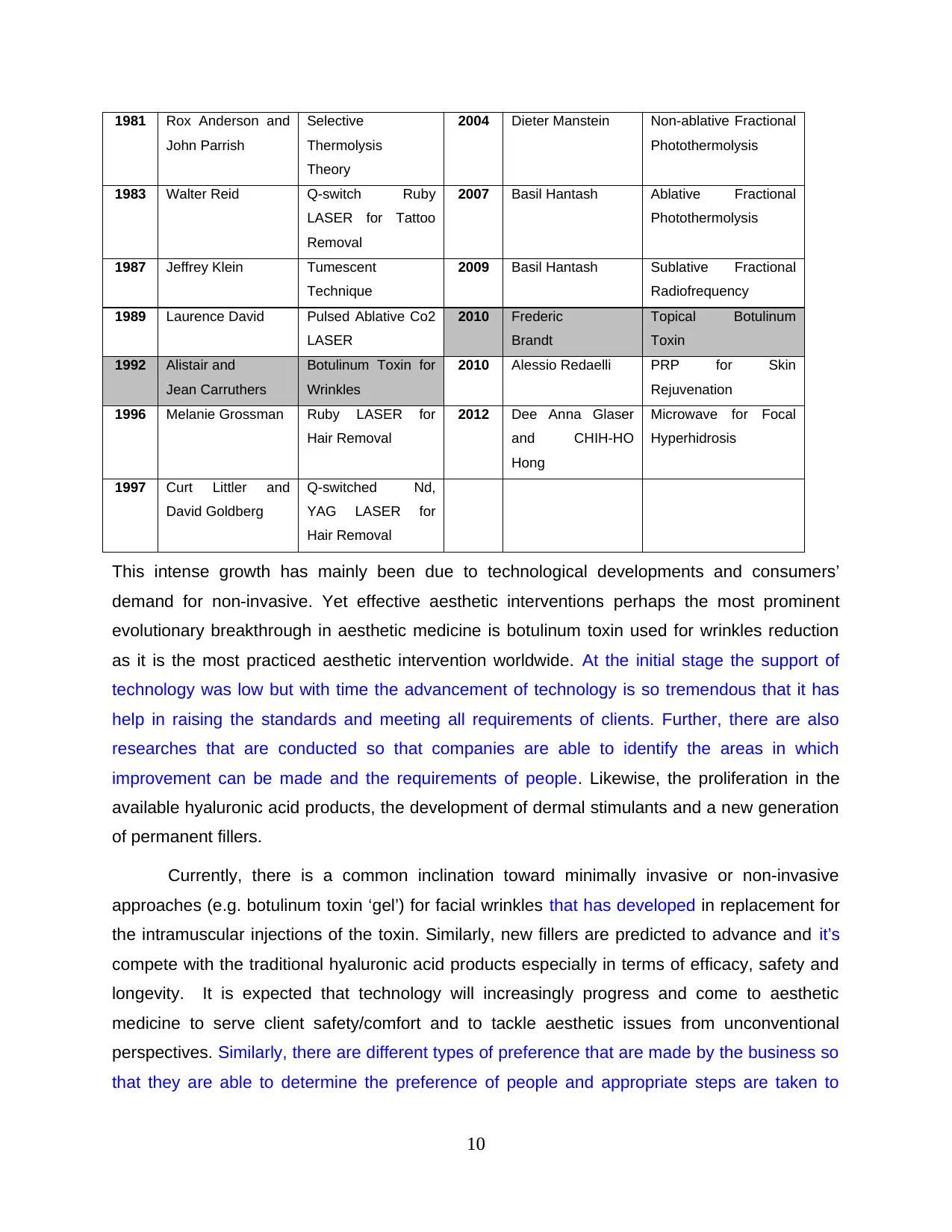
1981 Rox Anderson and
John Parrish
Selective
Thermolysis
Theory
2004 Dieter Manstein Non-ablative Fractional
Photothermolysis
1983 Walter Reid Q-switch Ruby
LASER for Tattoo
Removal
2007 Basil Hantash Ablative Fractional
Photothermolysis
1987 Jeffrey Klein Tumescent
Technique
2009 Basil Hantash Sublative Fractional
Radiofrequency
1989 Laurence David Pulsed Ablative Co2
LASER
2010 Frederic
Brandt
Topical Botulinum
Toxin
1992 Alistair and
Jean Carruthers
Botulinum Toxin for
Wrinkles
2010 Alessio Redaelli PRP for Skin
Rejuvenation
1996 Melanie Grossman Ruby LASER for
Hair Removal
2012 Dee Anna Glaser
and CHIH-HO
Hong
Microwave for Focal
Hyperhidrosis
1997 Curt Littler and
David Goldberg
Q-switched Nd,
YAG LASER for
Hair Removal
This intense growth has mainly been due to technological developments and consumers’
demand for non-invasive. Yet effective aesthetic interventions perhaps the most prominent
evolutionary breakthrough in aesthetic medicine is botulinum toxin used for wrinkles reduction
as it is the most practiced aesthetic intervention worldwide. At the initial stage the support of
technology was low but with time the advancement of technology is so tremendous that it has
help in raising the standards and meeting all requirements of clients. Further, there are also
researches that are conducted so that companies are able to identify the areas in which
improvement can be made and the requirements of people. Likewise, the proliferation in the
available hyaluronic acid products, the development of dermal stimulants and a new generation
of permanent fillers.
Currently, there is a common inclination toward minimally invasive or non-invasive
approaches (e.g. botulinum toxin ‘gel’) for facial wrinkles that has developed in replacement for
the intramuscular injections of the toxin. Similarly, new fillers are predicted to advance and it’s
compete with the traditional hyaluronic acid products especially in terms of efficacy, safety and
longevity. It is expected that technology will increasingly progress and come to aesthetic
medicine to serve client safety/comfort and to tackle aesthetic issues from unconventional
perspectives. Similarly, there are different types of preference that are made by the business so
that they are able to determine the preference of people and appropriate steps are taken to
10
John Parrish
Selective
Thermolysis
Theory
2004 Dieter Manstein Non-ablative Fractional
Photothermolysis
1983 Walter Reid Q-switch Ruby
LASER for Tattoo
Removal
2007 Basil Hantash Ablative Fractional
Photothermolysis
1987 Jeffrey Klein Tumescent
Technique
2009 Basil Hantash Sublative Fractional
Radiofrequency
1989 Laurence David Pulsed Ablative Co2
LASER
2010 Frederic
Brandt
Topical Botulinum
Toxin
1992 Alistair and
Jean Carruthers
Botulinum Toxin for
Wrinkles
2010 Alessio Redaelli PRP for Skin
Rejuvenation
1996 Melanie Grossman Ruby LASER for
Hair Removal
2012 Dee Anna Glaser
and CHIH-HO
Hong
Microwave for Focal
Hyperhidrosis
1997 Curt Littler and
David Goldberg
Q-switched Nd,
YAG LASER for
Hair Removal
This intense growth has mainly been due to technological developments and consumers’
demand for non-invasive. Yet effective aesthetic interventions perhaps the most prominent
evolutionary breakthrough in aesthetic medicine is botulinum toxin used for wrinkles reduction
as it is the most practiced aesthetic intervention worldwide. At the initial stage the support of
technology was low but with time the advancement of technology is so tremendous that it has
help in raising the standards and meeting all requirements of clients. Further, there are also
researches that are conducted so that companies are able to identify the areas in which
improvement can be made and the requirements of people. Likewise, the proliferation in the
available hyaluronic acid products, the development of dermal stimulants and a new generation
of permanent fillers.
Currently, there is a common inclination toward minimally invasive or non-invasive
approaches (e.g. botulinum toxin ‘gel’) for facial wrinkles that has developed in replacement for
the intramuscular injections of the toxin. Similarly, new fillers are predicted to advance and it’s
compete with the traditional hyaluronic acid products especially in terms of efficacy, safety and
longevity. It is expected that technology will increasingly progress and come to aesthetic
medicine to serve client safety/comfort and to tackle aesthetic issues from unconventional
perspectives. Similarly, there are different types of preference that are made by the business so
that they are able to determine the preference of people and appropriate steps are taken to
10
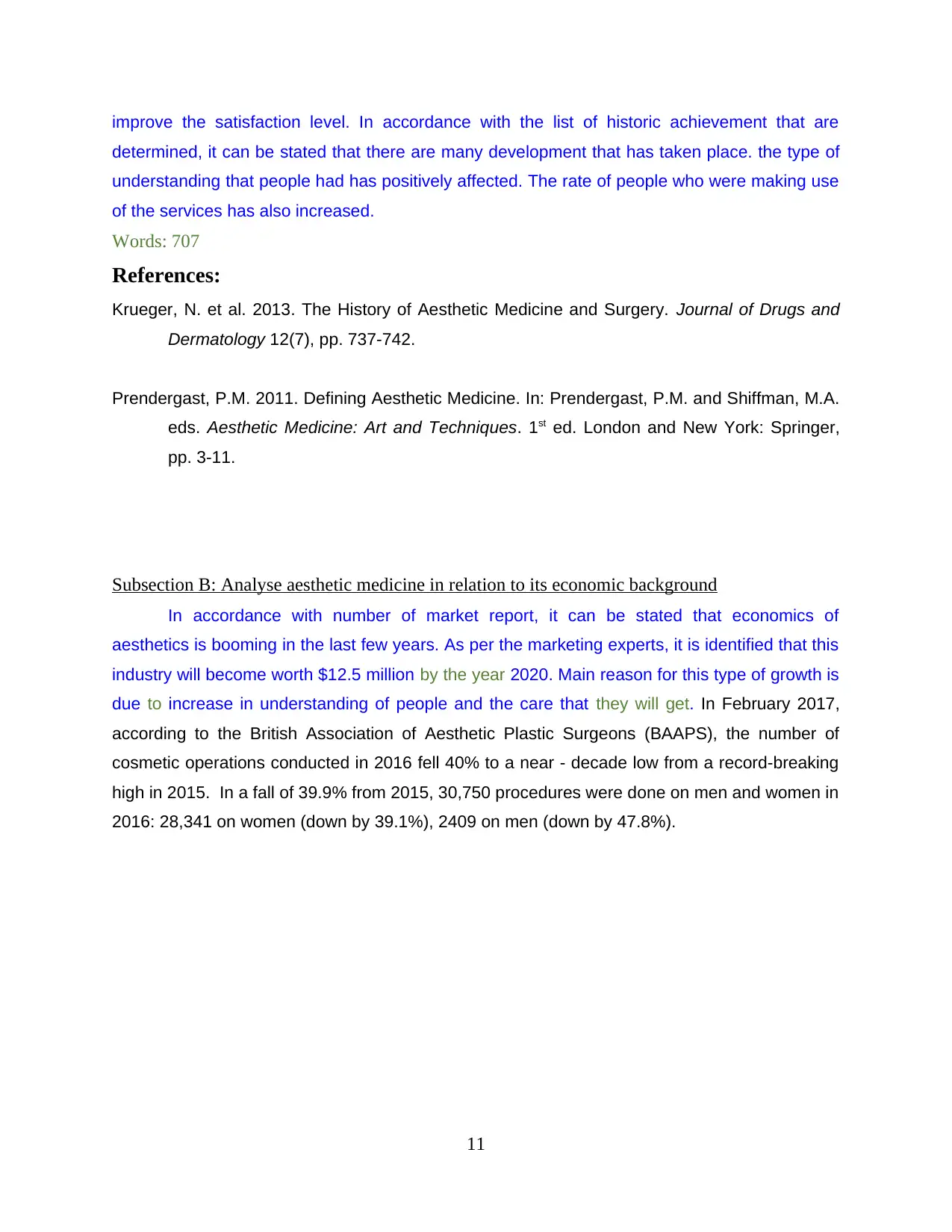
improve the satisfaction level. In accordance with the list of historic achievement that are
determined, it can be stated that there are many development that has taken place. the type of
understanding that people had has positively affected. The rate of people who were making use
of the services has also increased.
Words: 707
References:
Krueger, N. et al. 2013. The History of Aesthetic Medicine and Surgery. Journal of Drugs and
Dermatology 12(7), pp. 737-742.
Prendergast, P.M. 2011. Defining Aesthetic Medicine. In: Prendergast, P.M. and Shiffman, M.A.
eds. Aesthetic Medicine: Art and Techniques. 1st ed. London and New York: Springer,
pp. 3-11.
Subsection B: Analyse aesthetic medicine in relation to its economic background
In accordance with number of market report, it can be stated that economics of
aesthetics is booming in the last few years. As per the marketing experts, it is identified that this
industry will become worth $12.5 million by the year 2020. Main reason for this type of growth is
due to increase in understanding of people and the care that they will get. In February 2017,
according to the British Association of Aesthetic Plastic Surgeons (BAAPS), the number of
cosmetic operations conducted in 2016 fell 40% to a near - decade low from a record-breaking
high in 2015. In a fall of 39.9% from 2015, 30,750 procedures were done on men and women in
2016: 28,341 on women (down by 39.1%), 2409 on men (down by 47.8%).
11
determined, it can be stated that there are many development that has taken place. the type of
understanding that people had has positively affected. The rate of people who were making use
of the services has also increased.
Words: 707
References:
Krueger, N. et al. 2013. The History of Aesthetic Medicine and Surgery. Journal of Drugs and
Dermatology 12(7), pp. 737-742.
Prendergast, P.M. 2011. Defining Aesthetic Medicine. In: Prendergast, P.M. and Shiffman, M.A.
eds. Aesthetic Medicine: Art and Techniques. 1st ed. London and New York: Springer,
pp. 3-11.
Subsection B: Analyse aesthetic medicine in relation to its economic background
In accordance with number of market report, it can be stated that economics of
aesthetics is booming in the last few years. As per the marketing experts, it is identified that this
industry will become worth $12.5 million by the year 2020. Main reason for this type of growth is
due to increase in understanding of people and the care that they will get. In February 2017,
according to the British Association of Aesthetic Plastic Surgeons (BAAPS), the number of
cosmetic operations conducted in 2016 fell 40% to a near - decade low from a record-breaking
high in 2015. In a fall of 39.9% from 2015, 30,750 procedures were done on men and women in
2016: 28,341 on women (down by 39.1%), 2409 on men (down by 47.8%).
11
Paraphrase This Document
Need a fresh take? Get an instant paraphrase of this document with our AI Paraphraser
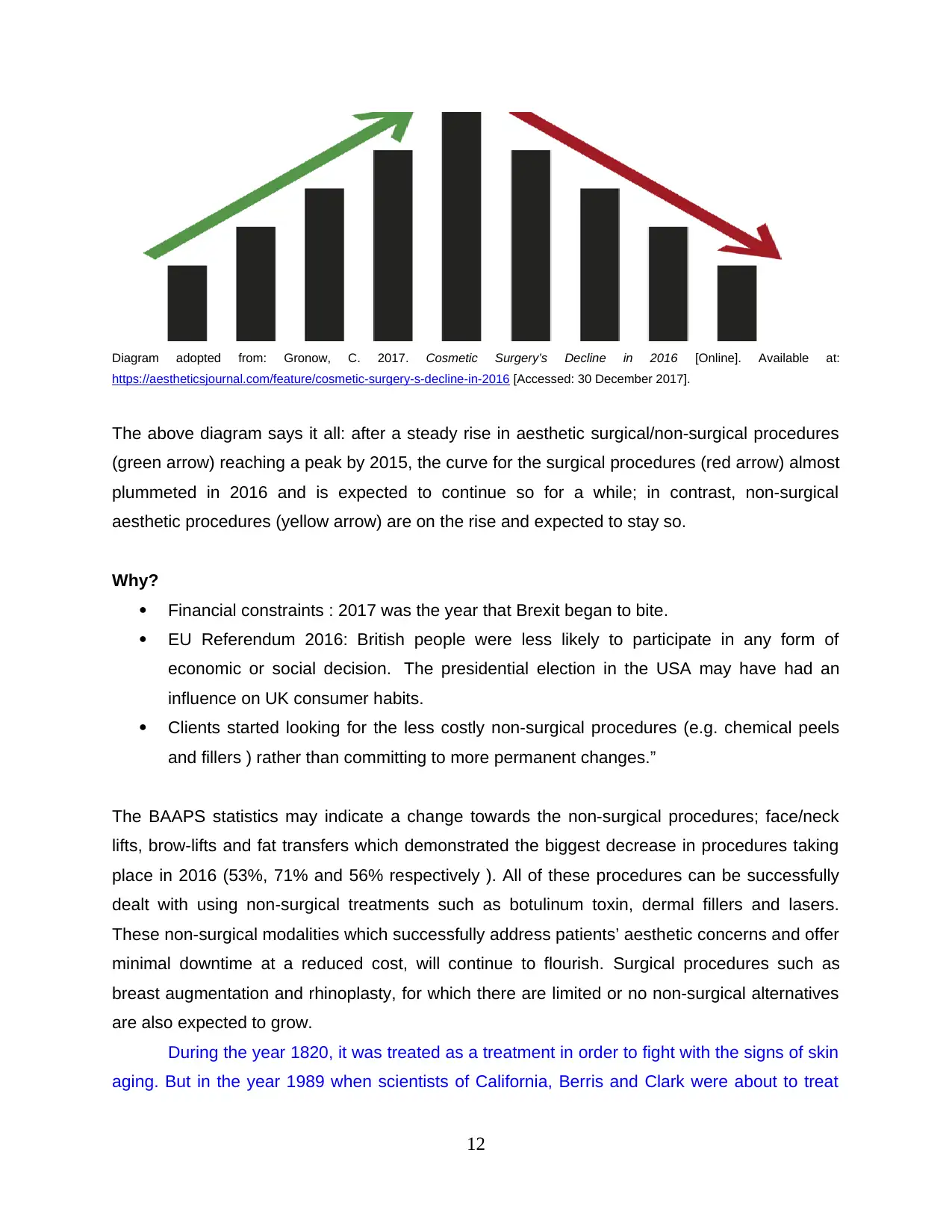
Diagram adopted from: Gronow, C. 2017. Cosmetic Surgery’s Decline in 2016 [Online]. Available at:
https://aestheticsjournal.com/feature/cosmetic-surgery-s-decline-in-2016 [Accessed: 30 December 2017].
The above diagram says it all: after a steady rise in aesthetic surgical/non-surgical procedures
(green arrow) reaching a peak by 2015, the curve for the surgical procedures (red arrow) almost
plummeted in 2016 and is expected to continue so for a while; in contrast, non-surgical
aesthetic procedures (yellow arrow) are on the rise and expected to stay so.
Why?
Financial constraints : 2017 was the year that Brexit began to bite.
EU Referendum 2016: British people were less likely to participate in any form of
economic or social decision. The presidential election in the USA may have had an
influence on UK consumer habits.
Clients started looking for the less costly non-surgical procedures (e.g. chemical peels
and fillers ) rather than committing to more permanent changes.”
The BAAPS statistics may indicate a change towards the non-surgical procedures; face/neck
lifts, brow-lifts and fat transfers which demonstrated the biggest decrease in procedures taking
place in 2016 (53%, 71% and 56% respectively ). All of these procedures can be successfully
dealt with using non-surgical treatments such as botulinum toxin, dermal fillers and lasers.
These non-surgical modalities which successfully address patients’ aesthetic concerns and offer
minimal downtime at a reduced cost, will continue to flourish. Surgical procedures such as
breast augmentation and rhinoplasty, for which there are limited or no non-surgical alternatives
are also expected to grow.
During the year 1820, it was treated as a treatment in order to fight with the signs of skin
aging. But in the year 1989 when scientists of California, Berris and Clark were about to treat
12
https://aestheticsjournal.com/feature/cosmetic-surgery-s-decline-in-2016 [Accessed: 30 December 2017].
The above diagram says it all: after a steady rise in aesthetic surgical/non-surgical procedures
(green arrow) reaching a peak by 2015, the curve for the surgical procedures (red arrow) almost
plummeted in 2016 and is expected to continue so for a while; in contrast, non-surgical
aesthetic procedures (yellow arrow) are on the rise and expected to stay so.
Why?
Financial constraints : 2017 was the year that Brexit began to bite.
EU Referendum 2016: British people were less likely to participate in any form of
economic or social decision. The presidential election in the USA may have had an
influence on UK consumer habits.
Clients started looking for the less costly non-surgical procedures (e.g. chemical peels
and fillers ) rather than committing to more permanent changes.”
The BAAPS statistics may indicate a change towards the non-surgical procedures; face/neck
lifts, brow-lifts and fat transfers which demonstrated the biggest decrease in procedures taking
place in 2016 (53%, 71% and 56% respectively ). All of these procedures can be successfully
dealt with using non-surgical treatments such as botulinum toxin, dermal fillers and lasers.
These non-surgical modalities which successfully address patients’ aesthetic concerns and offer
minimal downtime at a reduced cost, will continue to flourish. Surgical procedures such as
breast augmentation and rhinoplasty, for which there are limited or no non-surgical alternatives
are also expected to grow.
During the year 1820, it was treated as a treatment in order to fight with the signs of skin
aging. But in the year 1989 when scientists of California, Berris and Clark were about to treat
12
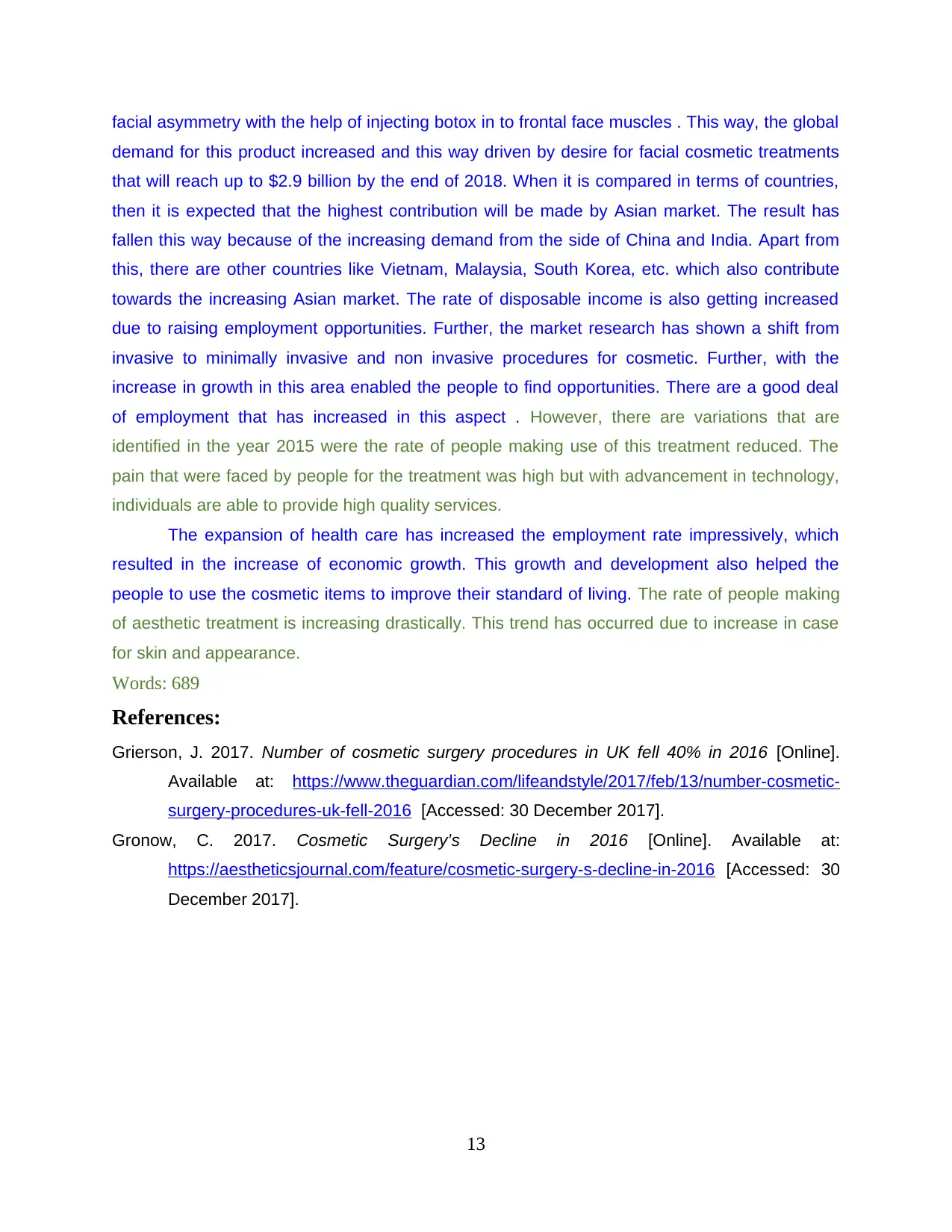
facial asymmetry with the help of injecting botox in to frontal face muscles . This way, the global
demand for this product increased and this way driven by desire for facial cosmetic treatments
that will reach up to $2.9 billion by the end of 2018. When it is compared in terms of countries,
then it is expected that the highest contribution will be made by Asian market. The result has
fallen this way because of the increasing demand from the side of China and India. Apart from
this, there are other countries like Vietnam, Malaysia, South Korea, etc. which also contribute
towards the increasing Asian market. The rate of disposable income is also getting increased
due to raising employment opportunities. Further, the market research has shown a shift from
invasive to minimally invasive and non invasive procedures for cosmetic. Further, with the
increase in growth in this area enabled the people to find opportunities. There are a good deal
of employment that has increased in this aspect . However, there are variations that are
identified in the year 2015 were the rate of people making use of this treatment reduced. The
pain that were faced by people for the treatment was high but with advancement in technology,
individuals are able to provide high quality services.
The expansion of health care has increased the employment rate impressively, which
resulted in the increase of economic growth. This growth and development also helped the
people to use the cosmetic items to improve their standard of living. The rate of people making
of aesthetic treatment is increasing drastically. This trend has occurred due to increase in case
for skin and appearance.
Words: 689
References:
Grierson, J. 2017. Number of cosmetic surgery procedures in UK fell 40% in 2016 [Online].
Available at: https://www.theguardian.com/lifeandstyle/2017/feb/13/number-cosmetic-
surgery-procedures-uk-fell-2016 [Accessed: 30 December 2017].
Gronow, C. 2017. Cosmetic Surgery’s Decline in 2016 [Online]. Available at:
https://aestheticsjournal.com/feature/cosmetic-surgery-s-decline-in-2016 [Accessed: 30
December 2017].
13
demand for this product increased and this way driven by desire for facial cosmetic treatments
that will reach up to $2.9 billion by the end of 2018. When it is compared in terms of countries,
then it is expected that the highest contribution will be made by Asian market. The result has
fallen this way because of the increasing demand from the side of China and India. Apart from
this, there are other countries like Vietnam, Malaysia, South Korea, etc. which also contribute
towards the increasing Asian market. The rate of disposable income is also getting increased
due to raising employment opportunities. Further, the market research has shown a shift from
invasive to minimally invasive and non invasive procedures for cosmetic. Further, with the
increase in growth in this area enabled the people to find opportunities. There are a good deal
of employment that has increased in this aspect . However, there are variations that are
identified in the year 2015 were the rate of people making use of this treatment reduced. The
pain that were faced by people for the treatment was high but with advancement in technology,
individuals are able to provide high quality services.
The expansion of health care has increased the employment rate impressively, which
resulted in the increase of economic growth. This growth and development also helped the
people to use the cosmetic items to improve their standard of living. The rate of people making
of aesthetic treatment is increasing drastically. This trend has occurred due to increase in case
for skin and appearance.
Words: 689
References:
Grierson, J. 2017. Number of cosmetic surgery procedures in UK fell 40% in 2016 [Online].
Available at: https://www.theguardian.com/lifeandstyle/2017/feb/13/number-cosmetic-
surgery-procedures-uk-fell-2016 [Accessed: 30 December 2017].
Gronow, C. 2017. Cosmetic Surgery’s Decline in 2016 [Online]. Available at:
https://aestheticsjournal.com/feature/cosmetic-surgery-s-decline-in-2016 [Accessed: 30
December 2017].
13
1 out of 15
Related Documents
Your All-in-One AI-Powered Toolkit for Academic Success.
+13062052269
info@desklib.com
Available 24*7 on WhatsApp / Email
![[object Object]](/_next/static/media/star-bottom.7253800d.svg)
Unlock your academic potential
© 2024 | Zucol Services PVT LTD | All rights reserved.





